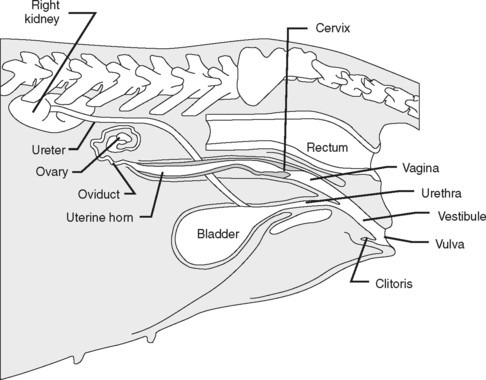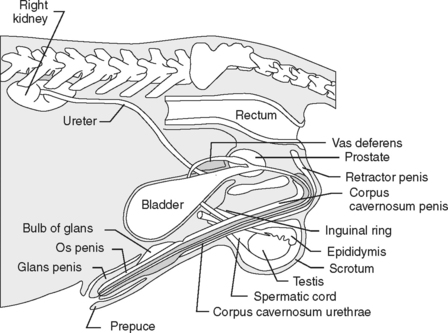Chapter 10 Diseases of the Reproductive System
The female reproductive system consists of two ovaries and the female duct system, including the oviducts, uterus, cervix, vagina, and vulva (Fig. 10-1). The primary functions of this system are to provide eggs for fertilization and to protect the developing embryo during pregnancy. All of these structures are composed of tissue that is sensitive to hormones produced by the female.

Figure 10-1 Female urinary and reproductive organs of bitch (lateral view).
(From Colville T, Bassert JM: Clinical anatomy and physiology for veterinary technicians, St Louis, 2002, Mosby, by permission.)
The male reproductive system consists of two testicles and the male duct system, including the urethra, prostate gland, and penis (Fig. 10-2). Other structures often involved with disease processes are the scrotum and the prepuce. The main hormonal influence in the male system is testosterone, although abnormal estrogen levels can also affect the male reproductive system.

Figure 10-2 Male urinary and reproductive organs of dog (lateral view).
(From Colville T, Bassert JM: Clinical anatomy and physiology for veterinary technicians, St Louis, 2002, Mosby, by permission.)
FEMALE REPRODUCTIVE DISEASE
Pyometra
DIAGNOSIS
TREATMENT
Pregnancy Disorders
Disorders of pregnancy include fetal death and abortion/reabsorption, dystocia, inappropriate maternal behavior, mastitis, and puerperal tetany. Although other problems are associated with pregnancy and parturition, these are the most commonly seen problems in small-animal medicine. The normal gestation period for the dog and cat is between 62 and 65 days. Fetuses can be palpated about 25 to 36 days after breeding in the dog, and 21 to 28 days in the cat. Fetal skeletal mineralization can be detected radiographically at 45 days gestation. Ultrasonography can provide information on the status of the fetuses after about 20 days. It is difficult to determine the number of fetuses, especially in large litters.



